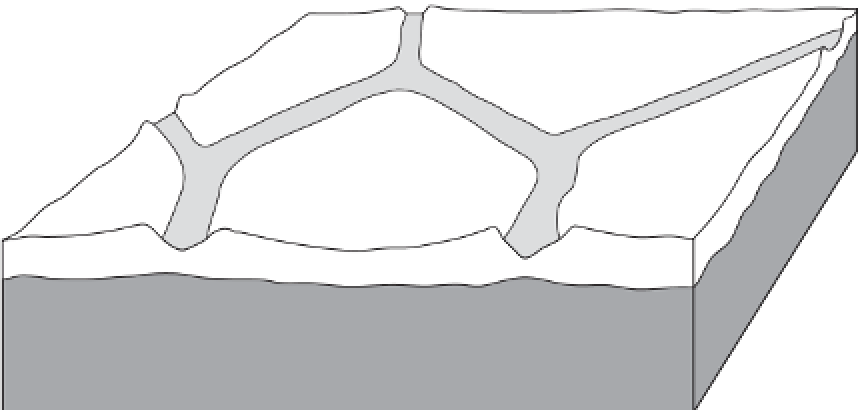Geology Reference
In-Depth Information
Water-filled
polygonal crack network
Pond
Ice
wedge
Pond
Thaw zone
Permafrost
Figure 11.3
Ice-wedges, ice-wedge polygons, and raised rims.
Source:
After Butzer (1976, 342)
Box 11.1
PINGOS
Pingos are approximately circular to elliptical in plan
(Colour Plate 14, inserted between pages 208 and 209).
They stand 3 to 70 m high and are 30 to 7,500 m
in diameter. The summit commonly bears dilation
cracks, caused by the continuing growth of the ice
core. Where these cracks open far enough, they may
expose the ice core, causing it to thaw. This process
creates a collapsed pingo, consisting of a nearly cir-
cular depression with a raised rim. Young pingos may
grow vertically around 20 cm a year, but older pin-
gos grow far less rapidly, taking thousands of years to
evolve. The growth of the ice at the heart of a pingo
appears to result from pressure exerted by water being
forced upwards. Water may be forced upwards in at
least two ways, depending on the absence (closed-
system pingos) or presence (open-system pingos) of
a continuing source of unfrozen water after the for-
mation of the initial core. First, in
closed-system
pingos
, a lake may be in-filled by sediment and veg-
etation, so reducing the insulation of the underlying,
unfrozen ground (Figure 11.4a). Freezing of the lake
surface will then cause permafrost to encroach from
the lake margins, so trapping a body of water. When
the entrapped water freezes, it expands and causes the
overlying sediments and vegetation to dome. The same
process would occur when a river is diverted or a
lake drained. This mechanism for the origin at cryo-
static pressure is supported by pingos in the Mackenzie
Delta region, North West Territories, in Arctic Canada,
where 98 per cent of 1,380 pingos recorded lie in, or
near to, lake basins. A second plausible mechanism for
forcing water upwards arises in
open-system pingos
(Figure 11.4b). Groundwater flowing under hydro-
static pressure may freeze as it forces its way towards
the surface from below a thin permafrost layer. How-
ever, unconfined groundwater is unlikely to generate
enough hydrostatic force to raise a pingo, and the
open-system mechanisms may occur under temporary
closed-system conditions as open taliks are frozen in
winter.














